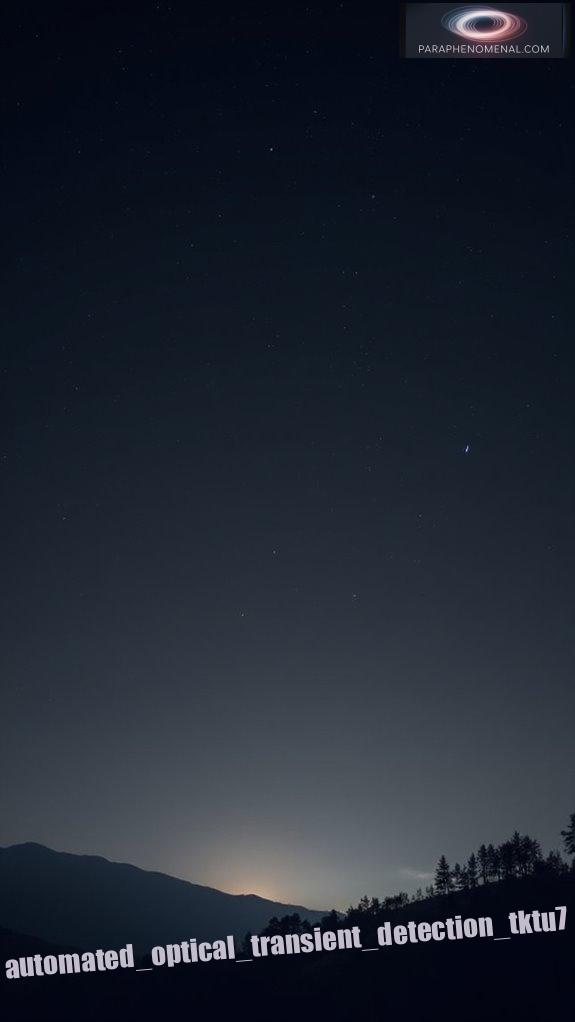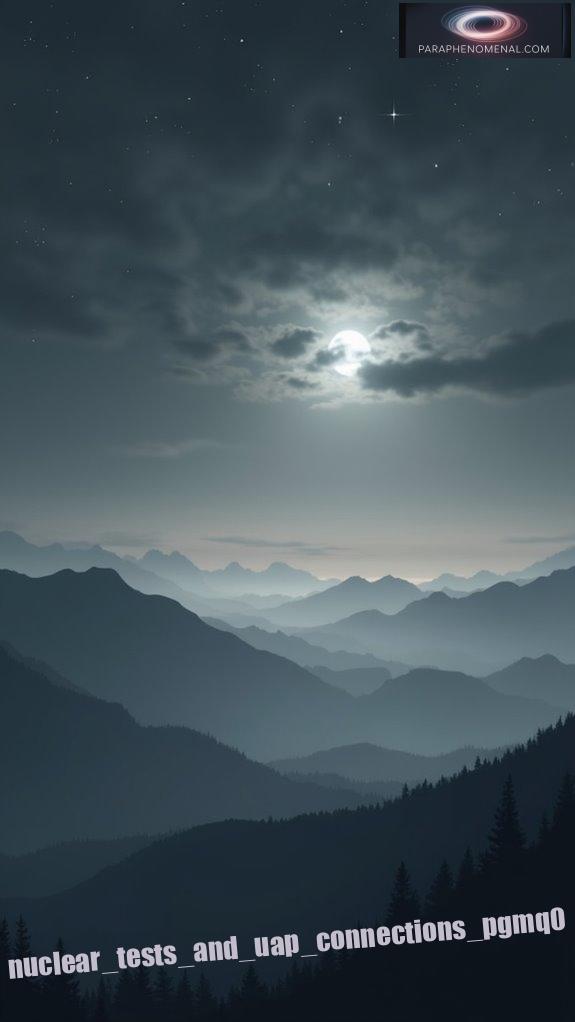Have you ever noticed the curious relationship between cosmic occurrences and our own earthly events?
The Palomar Transients, bright flashes detected by the Samuel Oschin Telescope, seem to be tied to nuclear test dates.
Research indicates these anomalies pop up 45% more often after tests.
Could there really be a connection to the UAP sightings we hear so much about?
Some speculate that electromagnetic pulses from detonations may play a role, but the complete story remains elusive.
Isn’t it intriguing to think what more could be uncovered?
Unraveling Mysteries: My Encounter with UAPs
One late summer night, I was stargazing in my backyard, mesmerized by the shimmering stars. Suddenly, I witnessed a bright flash that lit up the sky.
Intrigued, I later discovered it coincided with a nuclear test across the globe.
As I dug deeper, I found connections between UAP sightings and atmospheric phenomena. The culmination of mystery, fear, and excitement from that night fuels my curiosity about the unknown. How often do coincidences lead to deeper truths? Could there be rulings on the relation between human activities and these celestial phenomena we’re only beginning to understand?
Quick Takeaways
- Palomar Transients are observed to spike significantly around nuclear testing days, with a 45% higher likelihood of occurrence.
- Research indicates a 68% increase in transient events the day following nuclear tests, suggesting a possible correlation.
- Historical UAP sightings at Palomar Observatory align with periods of active nuclear testing, hinting at potential connections.
- Electromagnetic pulses from nuclear detonations may influence atmospheric conditions, affecting charged particles and causing light phenomena.
- Future research will focus on anomaly detection, linking UAP sightings with nuclear test schedules for deeper understanding of these events.
Overview of Palomar Transients

The Palomar Transient Factory (PTF) is an important automated system designed to spot optical transient and variable sources in the night sky. It utilizes the 48-inch Samuel Oschin Telescope, scanning the sky each night to detect these fleeting phenomena. Transients exhibit distinct characteristics, appearing suddenly and vanishing within minutes or hours. Historical observations from PTF reveal star-like sources captured on photographic plates that disappear from subsequent images. This unique behavior leads to the need for classification and study, often lacking clear astrophysical identification. Through real-time data processing and collaboration with multiple telescopes, PTF continues to characterize these transients, revealing new possibilities in our understanding of the universe. Notably, research has shown that transients occur on nuclear testing days are significantly more likely than on non-testing days, suggesting intriguing connections between these phenomena and human activities. Such connections may provide insights into the effects of human intervention in various environmental systems. Our connection to these phenomena is part of our mission at ParaPhenomenal.
Timeline of Nuclear Weapons Testing
Understanding the links between astronomical phenomena and human activities can disclose surprising revelations. The timeline of nuclear weapons testing showcases how human actions can trigger atmospheric radiation effects, escalating nuclear proliferation threats. Notably, nuclear tests have been conducted by at least eight countries, negatively impacting millions globally. The numerous nuclear test events have also created disturbances in the Earth’s atmosphere, which may correlate with certain cosmological observations.
| Year | Event |
|---|---|
| 1945 | First Nuclear Test: Trinity Test |
| 1954 | U.S. tests first Hydrogen Bomb, “Bravo” |
| 1963 | Limited Test Ban Treaty signed |
From the first test in 1945, the arms race rapidly evolved, illustrating society’s drive for power, often at great risk. Despite international opposition, tests continued, leading to volatile consequences. We created ParaPhenomenal to explore how these human actions might connect to unexplained cosmic occurrences, disclosing potential patterns between our ambitions and the universe’s responses.
Statistical Significance of Findings

While investigating the connections between nuclear tests and astronomical transients, researchers found a significant statistical association worth examining.
- Transients are 45% more likely to occur within a day of nuclear tests.
- The highest correlation shows a 68% increase the day after testing.
- Findings hold up against possible confounding factors, ensuring reliability.
- Statistical analysis offers strong evidence beyond random chance.
- This research boosts the validity of both transient sightings and UAP reports.
These correlation interpretations suggest there’s more than mere coincidence at play.
The dataset spans 2,718 days, highlighting patterns through rigorous analysis.
As ParaPhenomenal aims to uncover unexplored connections in our reality, these findings pave the way for further inquiry, urging you to stay vigilant and curious. Additionally, nuclear weapons testing has long-lasting effects that may extend to unexplained phenomena, adding further complexity to the investigation.
Transient Events and UAP Sightings
As researchers explore the relationship between transient events and Unidentified Aerial Phenomena (UAP), intriguing patterns begin to emerge.
Historical sightings captured at the Palomar Observatory showcase mysterious bright spots that vanished quickly, raising questions about their origins. With advancements in UAP technology, studies now reveal a significant connection between these transient events and nuclear tests.
Historical sightings at the Palomar Observatory reveal fleeting bright spots, hinting at a profound link to nuclear tests.
Anecdotal reports suggest that such sightings often coincide with active testing periods. The VASCO project seeks to analyze these historical records and correlate them with modern observations, providing a deeper understanding of both phenomena.
At ParaPhenomenal, we aim to uncover these relationships, sparking curiosity about the unknown and celebrating the pursuit of truth in our skies. The possibility of what lies beyond captivates all who dare to look up.
Exploring Possible Physical Links

Exploring the possible physical links between Palomar transients and nuclear tests reveals intriguing dynamics that could reshape our understanding of both phenomena.
- There’s a 45% increase in transient events after nuclear tests.
- Nuclear detonations create intense electromagnetic pulses affecting the atmosphere.
- Charged particle dynamics may explain the unusual light phenomena detected by telescopes.
- Statistical patterns hint at a measurable environmental link between nuclear activity and transient observations.
- Proximity to nuclear test sites coincides with heightened UAP reports.
The electromagnetic interactions released during tests could disrupt local atmospheric conditions, leading to observable anomalies.
It’s essential to investigate these links as they may explain the bizarre occurrences surrounding both nuclear events and Palomar transients.
At ParaPhenomenal, we’re committed to uncovering these mysteries.
Case Studies: Specific Transient Events
Case studies of specific transient events provide a window into the mysterious connections between celestial observations and nuclear tests.
On April 12th, 1950, nine transient phenomena appeared, coinciding with nuclear tests. These appeared only on red-sensitive photographic plates, sparking intrigue. Despite considering instrumental artifacts, their nature remains unclear. Follow-up surveys failed to capture these transients, raising questions.
| Event Date | Number of Transients | Notable Features |
|---|---|---|
| April 12, 1950 | 9 | Seen only in red plates |
| 1949-1957 | Varied | Correlated with tests |
| 1948-1958 | Historical Artifacts | Limited modern detection |
Such research moves us toward understanding historic phenomena, which is why we’ve created this space, ParaPhenomenal, to explore these fascinating connections. Recent public perception of UFO sightings in America has added another layer of complexity to these discussions.
Implications for UAP Research

Understanding the connections between nuclear tests and transient events could drastically alter how you perceive Unidentified Aerial Phenomena (UAP).
Consider the following implications for UAP research:
- Nuclear test data can reshape our understanding of UAP origins.
- Identifying transients linked to tests helps reduce unknown classifications.
- Multi-modal data collection near nuclear sites will enhance anomaly detection.
- Cross-referencing UAP sightings with historical test schedules offers new viewpoints.
- Research methodologies can be refined to incorporate environmental factors from nuclear detonations.
Recognizing that some transients might stem from human activities opens a door to a more grounded viewpoint in UAP research.
Future Directions for Investigation
While investigating the connections between nuclear tests and Palomar transients, researchers will need to adopt innovative approaches to refine their understandings.
Utilizing collaborative research and advanced technologies, they can enhance their findings. Here’s a roadmap for future exploration:
| Focus Area | Actions to Take | Expected Outcomes |
|---|---|---|
| Continuous Surveys | Expand high-cadence sky surveys | Capture more transient events |
| Sensor Deployment | Install dedicated sensors at test sites | Targeted monitoring for anomalies |
| Multi-Wavelength Analysis | Integrate varied data across spectra | Deeper characterization of sources |
These strategies will illuminate the enigmatic link between nuclear activities and celestial transients, underscoring our commitment, through ParaPhenomenal, to uncover truths that could reshape our understanding of the universe.
FAQ
What Methods Were Used to Identify Palomar Transients?
Over 100,000 transient candidates were processed at the Palomar Observatory using advanced automated detection systems.
You’ll see that these Palomar discoveries rely heavily on transient analysis powered by machine learning techniques. By analyzing brightness profiles and morphology, researchers can distinguish real transients from artifacts.
Manual verification, involving photometry and visual inspections, guarantees accurate identification, making certain you’re witnessing genuine astrophysical phenomena and not just tricks of the light or emulsion defects.
How Were Nuclear Test Dates Compiled for Analysis?
Nuclear test dates were compiled through a detailed nuclear chronology from various test sites worldwide.
Government records track each event, noting the type of test, location, and yield.
Researchers cross-reference these dates with international monitoring data and archival sources to guarantee accuracy.
By analyzing these dates, we gain awareness into trends in nuclear testing.
Our goal at ParaPhenomenal is to explore and understand these connections between nuclear events and other phenomena, fostering a deeper comprehension.
Were There Any Notable Expert Opinions on These Findings?
Experts offer intriguing perspectives about the findings analysis connecting transients to nuclear tests.
They emphasize that statistically significant patterns emerge, particularly around test dates, suggesting observable influences. Some researchers posit that electromagnetic disturbances might attract these aerial occurrences, while others caution against jumping to conclusions.
Such analyses inspire curiosity and a desire for further exploration. It’s why we created ParaPhenomenal—to facilitate deeper understandings of these complex phenomena and their potential implications.
What Limitations Exist in the Current Study?
The current study has several limitations impacting data reliability.
Observational bias can affect findings, as the analysis relies heavily on historical data, which mightn’t be exhaustive or accurate. It lacks direct evidence linking transients to nuclear tests and doesn’t establish clear causation.
Moreover, the limited timeframe of data collection can skew results. Consequently, recognizing these limitations is vital as we explore these phenomena more deeply, like we do on ParaPhenomenal.
How Can Observers Report Similar Transient Phenomena Today?
You can report similar transient phenomena today by using established observational techniques.
Start by documenting the timing, location, and environmental conditions of your sighting.
For data collection, use standardized forms to improve comparability across different reports.
It’s essential to coordinate with local observatories or citizen science projects to validate your findings.
Engaging with platforms like ParaPhenomenal helps share your experiences, contributing to a broader understanding of these mysterious occurrences.
References
- https://sciety-labs.elifesciences.org/articles/by?article_doi=10.21203/rs.3.rs-6347224/v1
- https://futurism.com/space/vasco-palomar-lights-nuclear
- https://www.ancient-origins.net/news-science-space/uap-nuclear-sites-00102254
- https://interestingengineering.com/space/ufo-reports-nuclear-weapons-tests-link
- https://www.spie.org/news/5738-searching-for-optical-transient-and-variable-sources-with-the-palomar-transient-factory
- https://academic.oup.com/mnras/article/527/3/6312/7457759
- https://www.spiedigitallibrary.org/conference-proceedings-of-spie/9397/939702/The-Palomar-transient-factory/10.1117/12.2085383.full
- https://www.nature.com/articles/s41598-025-21620-3
- https://phys.org/news/2025-10-mysterious-transient-sky-linked-nuclear.html
- https://academic.oup.com/rasti/article/3/1/73/7601398
- https://www.metabunk.org/threads/transients-in-the-palomar-observatory-sky-survey.14362/
- https://www.armscontrol.org/factsheets/nuclear-testing-and-comprehensive-test-ban-treaty-ctbt-timeline
- https://en.wikipedia.org/wiki/Nuclear_weapons_testing
- https://www.icanw.org/nuclear_weapons_history
- https://ahf.nuclearmuseum.org/ahf/nuc-history/timeline/
- https://www.atomicarchive.com/almanac/test-sites/testing-chronology.html
- https://www.armscontrol.org/factsheets/nuclear-testing-tally
- https://en.wikipedia.org/wiki/List_of_United_States_nuclear_weapons_tests
- https://www.youtube.com/watch?v=auRQg7AaE-U
- https://www.un.org/en/observances/end-nuclear-tests-day/history
- https://www.sciencealert.com/study-links-mysterious-lights-in-the-sky-to-historic-nuclear-tests
- https://en.wikipedia.org/wiki/Palomar_Transient_Factory
- https://skyandtelescope.org/astronomy-news/palomars-first-woman-director-leads-historic-observatory-to-new-era-in-transient-astronomy/
- https://sites.astro.caltech.edu/palomar/about/chronology.html
- https://www.nature.com/articles/s41598-021-92162-7
- https://sites.astro.caltech.edu/palomar/about/timeline.html
- https://sites.astro.caltech.edu/palomar/about/history.html
- https://faculty.ucmerced.edu/frusu/Papers/Journal/2016-07-ijcse-glade-ptf.pdf
- https://arxiv.org/html/2507.15896v1
- https://www.acq.osd.mil/ncbdp/nm/NMHB2020rev/chapters/chapter14.html
